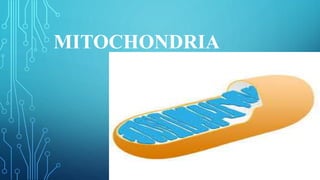
1663838359563_MITOCHONDRIA.pptx
- 1. MITOCHONDRIA
- 2. MITOCHONDRIA •Mitochondria are known as the powerhouses of the cell. They are organelles that act like a digestive system which takes in nutrients, breaks them down, and creates energy rich molecules for the cell. •The biochemical processes of the cell are known as cellular respiration. •Mitochondria are located in the cytoplasm of cells along with other organelles of the cell.
- 3. •The heart muscle cells – with about 5,000 mitochondria per cell. These cells need more energy, so they contain more mitochondria than any other organ in the body. •In humans, the mature egg cell, or oocyte, contains the highest number of mitochondria among human cells, ranging from 100,000 to 600,000 mitochondria per cell, but each mitochondrion contains only one copy. •The cell's powerhouses — and their DNA are inherited exclusively from mothers.
- 4. •Mitochondria, often referred to as the “powerhouses of the cell”, were first discovered in 1857 by physiologist Albert von Kolliker, and later coined “bioblasts” (life germs) by Richard Altman in 1886. • The organelles were then renamed “mitochondria” by Carl Benda twelve years later.
- 6. STRUCTURE AND FUNCTION • Mitochondria made of two membranes. The outer membrane covers the organelle and contains it like a skin. The inner membrane folds over many times and creates layered structures called cristae. The fluid contained in the mitochondria is called the matrix. • The cristae greatly increase the total surface area of the inner membrane. ... The membranes create two compartments. • The inner membrane space, as implied, is the region between the inner and outer membranes. It has an important role in the primary function of mitochondria, which is oxidative phosphorylation (process in which ATP is formed)
- 7. •Its size ranges from 0.5 to 1.0 micrometer in diameter. The structure comprises an outer membrane, an inner membrane, and a gel-like material called the matrix. • The outer membrane and the inner membrane are made of proteins and phospholipid layers separated by the inner membrane space. •Ribosomes have two main functions — decoding the message and the formation of peptide bonds. These two activities reside in two large ribonucleoprotein particles (RNPs) of unequal size, the ribosomal subunits. •Each subunit is made of one or more ribosomal RNAs (rRNAs) and many ribosomal proteins (r-proteins).
- 9. • Mitochondria are known as the powerhouses of the cell. Mitochondria are a double-membrane-bound cell organelle found in most eukaryotic organisms. • In all living cells, these cell organelles are found freely floating within the cytoplasm of the cell. • They are sites of cellular respiration. • They uses oxygen to oxidize carbohydrates and fats present in the cell to carbon dioxide and water. Oxidation releases energy, a portion of which is used to form ATP. Since mitochondria synthesizes energy rich compound ATP it is called powerhouse of cell.
- 11. • The heart muscle cells – with about 5,000 mitochondria per cell. These cells need more energy, so they contain more mitochondria than any other organ in the body. • 5 Roles Mitochondria Play in Cells • Production of ATP. Perhaps the most well-known role of mitochondria is the production of ATP, the energy currency of cells. • Calcium Homeostasis. • Regulation of Innate Immunity. • Programmed Cell Death. • Stem Cell Regulation.
- 12. • Mitochondria, organelles specialized to carry out aerobic respiration, contain an inner membrane folded into cristae, which form two separate compartments: the inner membrane space and the matrix. • Mitochondria convert chemical energy from the food we eat into an energy form that the cell can use. This process is called oxidative phosphorylation. The Krebs cycle produces a chemical called NADH. NADH is used by enzymes embedded in the cristae to produce ATP.
- 13. MITOCHONDRIA VS CHLOROPLAST • Mitochondria and chloroplast are organelles found in a plant cell. However, chloroplast is absent in an animal but mitochondria is found in both. Mitochondria generates energy for the cell in the form of ATP using oxygen and nutrients. Chloroplast is the site for photosynthesis in a plant cell. • Mitochondria and chloroplasts are the same size as prokaryotic cells and divide by binary fission. Mitochondria and chloroplasts have their own DNA which is circular, not linear. Mitochondria and chloroplasts have their own ribosomes which have 30S and 50S subunits, not 40S and 60S.